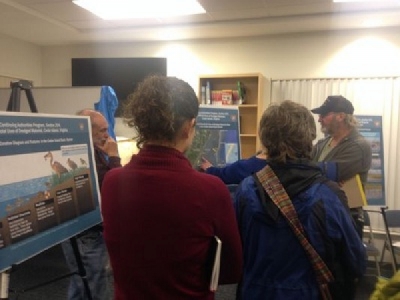
Posted on December 13, 2016
By Carol Vaughn, delmarvanow
Dozens of Eastern Shore of Virginia residents came to the Virginia Institute of Marine Science’s Eastern Shore Laboratory in Wachapreague Tuesday to ask questions and make comments about a proposal to make beneficial use of dredging spoils offshore of the town.
The U. S. Army Corps of Engineers held the open house-style event to give the public a chance to find out more about what is being considered and to solicit the public’s help in identifying issues, alternatives and potential impacts of the project.
“We basically just initiated a federal study. This is part of our program to help study how to enhance and protect our shoreline and tidal wetlands in the back barrier of Cedar Island,” said Alicia Logalbo, chief of the environmental analysis section of the U. S. Army Corps of Engineers Norfolk District.
The main purpose of the project is to provide environmental benefits, but it also could help protect Wachapreague’s shoreline, Logalbo said.
The head of a committee studying dredging needs on Virginia’s Eastern Shore was among those at the open house.
“What we’re hoping for is that this can provide a template for beneficial use of dredge spoils on both sides of the Eastern Shore — and up and down the Eastern Shore,” said John Joeckel, chairman of the Eastern Shore Regional Waterways Committee.
The committee, which includes members from both Accomack and Northampton counties, was established earlier this year to address the Virginia Eastern Shore’s dredging needs.
At issue with the Corps’ current study of the area off Wachapreague is how best to use dredged material from the Cedar Island Bay Channel, Burtons Bay Channel, FInney Creek Channel and the Bradford Bay Channel to expand and protect the back-barrier shoreline wetlands and marsh areas of Cedar Island — and to protect the town of Wachapreague.
“We’re basically looking at alternative beneficial uses of dredge material placement,” said Chris Turner, U. S. Army Corps project manager for the Waterway on the Coast of Virginia.
Turner said that historically, the Corps over the past 30 years has dredged Finney Creek, Wachapreague Channel and Bradford Bay Channel and has placed the dredged material at an overboard site in Bradford Bay Channel.
“I think the need is, at some point in the next 20 years we’re going to reach capacity, so we’re looking at other alternatives for placement,” he said.
The agency is requesting public comment on alternatives under consideration for using the spoils, as well as any concerns.
The Army Corps at this point is considering various options for using the spoils, including thin-layer spraying — where dredged material would be put on parts of the shoreline and wetlands behind Cedar Island — as well as constructing mudflats with oyster reefs.
Objectives of the project include reducing the current rate of shoreline and marsh loss due to erosion; enhancing fish and wildlife habitat; increasing intertidal mudflat habitat to provide more foraging areas for birds; and increasing shoreline protection for the town of Wachapreague, according to a February 2016 Army Corps document, “Federal Interest Determination Continuing Authority Feasibility Investigation Section 204 Beneficial Uses of Dredged Material.”
A study for the project, required under the National Environmental Police Act, should be completed within the next 12 to 18 months, with the project slated to go to construction likely within the next three to five years, Turner said.
A draft version of the NEPA document should be ready by January 2018. It will describe the feasibility study, identify a preferred alternative and give an environmental analysis of the various alternatives considered. After its release, the public will again have an opportunity to comment before the final document is approved.
Comments on the Continuing Authorities Program, Section 204 Beneficial Uses of Dredged Material Cedar Island, Virginia Feasibility Study may be submitted until Dec. 30, 2016 to RIchard Harr, USACE, via email at richard.m.harr@usace.army.mil or by mail: ATTN: Richard Harr, Department of the Army, U. S. Army Corps of Engineers, Norfolk District, Fort Norfolk, 803 Front St., Norfolk, VA 23510 or telephone 757-201-7746.
Source: delmarvanow





